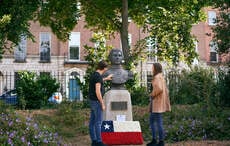Recently discovered French documents show compelling evidence that the grave of W.B. Yeats in Drumcliffe churchyard contains the bones of someone else.
The Irish poet’s bones were transferred from France for reburial in the Co. Sligo graveyard in September 1948. There were doubts about the authenticity of the remains even then, and Yeats’s friends, who were aware that his remains had been scattered in an ossuary in 1946, tried to dissuade the poet’s widow, George, from going through with the repatriation, the Irish Times reports.
Nine years after the Yeats's death, a French diplomat named Bernard Cailloux was sent to Roquebrune, France, in 1948 to locate the poet's remains. He reported that it was “impossible to return the full and authentic remains of Mr Yeats” and suggested asking Dr Rebouillat, a local pathologist, “to reconstitute a skeleton presenting all the characteristics of the deceased.”
At best, Cailloux wrote, it might be possible to find “an iron corset, a skull, and perhaps a Bible.” Because Yeats had an unusually large skull, it is conceivable that his skull was actually found and sent to Ireland, but the French documents indicate that it is likely that the remains of several people are buried in the grave in Sligo.
Diplomatic correspondence referring to Cailloux’s report strongly implies that his recommendation to assemble a skeleton from a mix of bones was followed, and the procedure had the tacit acceptance of the Yeats family and minister for external affairs Seán MacBride, who was the son of Yeats’s lover Maud Gonne.
“We can be assured of the discretion of the family and the Irish authorities,” Stanislas Ostrorog, the head of the French legation to Ireland, wrote to Jacques Camille Paris, the Europe director of the French foreign ministry, on August 12th, 1948.
He added that “certain precautions must be taken on our side to avoid any indiscretion about the procedure undertaken a few months ago to obtain the remains of the poet . . . so that no administrative difficulties arise giving cause for suspicion; so that no inopportune explanation is given to the Irish present at the ceremony.”
Yeats died at the Hôtel Idéal Séjour in Roquebrune on January 28th, 1939. “If I die, bury me up there” - the churchyard in Roquebrune – “and then in a year’s time when the newspapers have forgotten me, dig me up and plant me in Sligo,” he told his wife. World War II prevented her from carrying out Yeat’s wishes.
In 1947, Yeat’s last lover, journalist Edith Shackleton Heald, and her lover Hannah Gluckstein, the painter known as Gluck, decided to visit the poet’s tomb, and were appalled to find that he had been disinterred a year before and his bones mixed with others in the ossuary.
In January 1948 the Times announced that George Yeats intended to repatriate the poet’s remains. Yeats’s friends protested, with Gluck saying “these remains would be almost impossible to find, and if found, identity would be open to doubt.”
Ostrorog, the French ambassador in Dublin, wrote to Paris, the Europe director at the foreign ministry: “A few months ago, the poet’s son came to see me to tell me, under the seal of secrecy, that they are unable to find the poet’s remains in the Roquebrune cemetery where the inhumation had taken place in 1939.”
Ostrorog warned that if not properly handled, the case “risks causing us serious trouble . . . I was most anxious to resolve the issue, for if the family and the Irish legation were obviously guilty of negligence, the French authorities could also be taken to task if it were known that this great foreign poet, who had spent so many years of his life in France, had been thrown into a communal grave.
“As you know,” he continued, “an investigation was first carried out by Mr Cailloux, sent specially by the cabinet. Following this, the remains were collected and placed in a coffin.”
On March 20th, 1948, Cailloux, who suggested Dr. Rebouillat reconstitute a skeleton, went with five other men to the ossuary for the exhumation. When Dr. Rebouillat drafted the certificate of exhumation he wrote that “recognition was established with certainty and precision . . . These bones were . . . placed in the coffin which was closed, soldered and sealed in our presence.”
Ostrorog “summoned the young Yeats to inform him, without giving any details, that following an investigation, the mortal remains of his father had been collected and were currently in a coffin in Roquebrune cemetery. He thanked me wholeheartedly, avoiding asking for any other explanation.”
Ostrorog wrote that a few weeks later he met Seán MacBride, who “expressed to me personally in the warmest terms his thanks for the care with which this affair had been resolved . . . We understood each other without it being spelled out. MacBride’s mother was formerly extremely close to the poet. There was obviously an interest that no incident would happen that could give rise to a press campaign.”
“It should notably be understood that if, by chance, the Irish were surprised to find themselves in front of a new coffin, we would explain that these measures were taken for the transport to Ireland,” Ostrorog wrote. “The Irish ambassador in Paris will, no doubt, attend the ceremony. But he is not aware of anything. What purpose would it serve?”
Jacques Camille Paris classified his correspondence with Ostrorog, Cailloux’s report and Rebouillat’s certificate of exhumation as “personal correspondence”, and took these documents with him to Strasbourg when he became the first secretary general of the Council of Europe.
When Paris he in 1953, the trunk containing the correspondence was given to his widow, Reine, the daughter of the French writer Paul Claudel. She stored it in the Claudel family chateau, in Brangues, in southeastern France. It was recently opened by Daniel Paris, the son of Jacques Camille and Reine, who turned the documents over to the Irish Embassy in Paris last month.
The Irish Times reports that the embassy entrusted the documents to French foreign-ministry archivists, who will send high-quality facsimiles to the National Library of Ireland later this year.




Comments